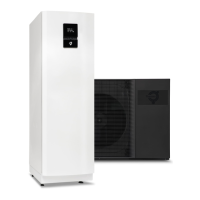4.3.2 Installation location requirements
▪
The outdoor unit shall be installed in an open space that is always ventilated.
▪
The national f-gas regulations shall be observed.
▪
For installation inside a building (this applies either to indoor or outdoor units installed inside) a minimum room floor area of space
conditioned is mandatory according to IEC 60335-2-40:2018.
▪
To handle, purge, and dispose the refrigerant, or break into the refrigerant circuit, the worker should have a certificate from an
industry-accredited authority.
4.3.3 Preparation of fire extinguisher
▪
If any hot work is to be done, an appropriate fire extinguishing equipment should have been available.
▪
A dry powder or CO2 fire extinguisher shall be equipped at the charging area.
4.3.4
Ignition sources free
Caution Make sure to store the units in a place without continuously operating
ignition sources (for example, open flames, an operating gas appliance
or an operating electric heater).
▪
The installer shall not use any ignition sources with the risk of fire or explosion.
▪
Potential ignition sources shall be kept away from the work area where the flammable refrigerant can possibly be released to the
surrounding.
▪
The work area should be checked to ensure that there are no flammable hazards or ignition risks. The “No Smoking” sign shall be
attached.
▪
Under no circumstances shall potential sources of ignition be used while in detection of leakage.
▪
Safe parts are the ones with which the worker can work in a flammable atmosphere. Other parts may result in ignition due to leak-
age.
▪
Replace components only with parts specified by Thermia. Other parts may result in the ignition of refrigerant in the atmosphere
from a leak.
4.3.5
Area ventilation
▪
Make sure that the work area is well ventilated before performing any possible hot work.
▪
Ventilation shall be adequate during the installation work.
▪
The ventilation should safely disperse any released gases and expel them into the atmosphere, away from the work area.
4.3.6
Leakage detection methods, if checking for possible leakage
▪
The leakage detector shall be calibrated in a refrigerant-free area.
▪
Make sure that the detector is not a potential source of ignition.
▪
The leakage detector shall be set to the LFL (lower flammability limit).
▪
The use of detergents containing chlorine shall be avoided for cleaning because the chlorine may react with the refrigerant and
corrode the pipes.
▪
If leakage is suspected, naked flames shall be removed.
▪
If a leakage is found while in brazing, the entire refrigerant shall be recovered from the product or isolated (e.g. using shut-off
valves). It shall not be directly released to the environment. Oxygen free nitrogen (OFN) shall be used for purging the system before
and during the brazing process.
▪
The work area shall be checked with an appropriate refrigerant detector before and during work.
▪
Ensure that the leakage detector is appropriate for use with flammable refrigerants.
Installation Guide
iTec XT
Thermia AB AWIXT01IG0102
27

